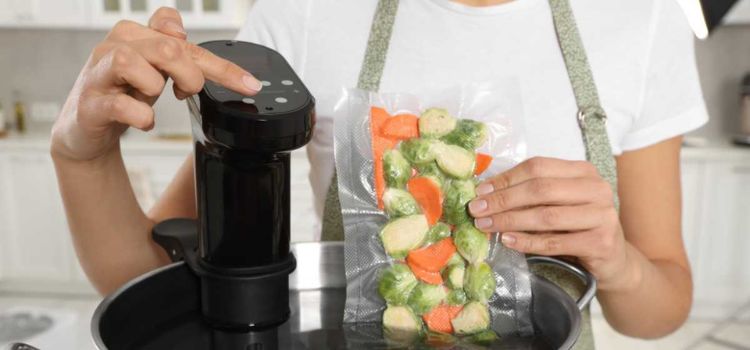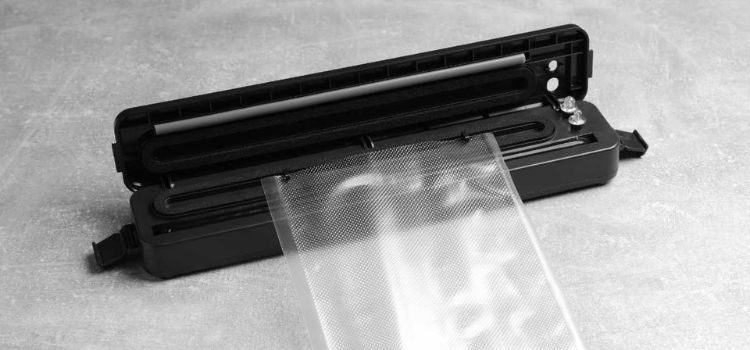As an Amazon Associate, I earn from qualifying purchases

Sous vide cooking has taken the culinary world by storm, offering a precise and foolproof way to prepare meals. This method involves cooking food in a water bath at a controlled temperature, ensuring even cooking and retaining moisture and flavor. As sous vide gains popularity among home cooks and professional chefs alike, the question arises: is a vacuum sealer necessary for this cooking technique?
Vacuum sealing is often associated with sous vide, as it involves removing air from the packaging to create a tight seal around the food. This process is believed to enhance the sous vide experience, but is it truly essential? In this article, we’ll explore the role of vacuum sealing in sous vide, examine alternatives, and weigh the pros and cons to help you decide if investing in a vacuum sealer is right for you.
The Role of Vacuum Sealing in Sous Vide
Vacuum sealing plays a significant role in sous vide cooking by ensuring that the food is tightly encased in a bag, allowing for even heat distribution and preventing water from entering the packaging. This method enhances the cooking process in several ways:
- Even Cooking and Flavor Infusion: By vacuum sealing, the food is in direct contact with the marinade or seasoning, allowing flavors to infuse deeply. The absence of air pockets ensures that the heat is evenly distributed, resulting in perfectly cooked meals every time.
- Prevention of Water Ingress: Vacuum-sealed bags are less likely to allow water to seep in, which can dilute flavors and affect the texture of the food. This is particularly important for delicate items like fish or eggs, where maintaining the integrity of the dish is crucial.
- Extended Shelf Life: Vacuum sealing also extends the shelf life of food by reducing exposure to air, which can cause spoilage. This is an added benefit for those who like to prepare meals in advance or buy in bulk.
Alternatives to Vacuum Sealers
While vacuum sealers offer several advantages, they are not the only option for sous vide cooking. Many home cooks successfully use alternatives such as zip-top bags and the water displacement method:
- Zip-Top Bags: These are a convenient and cost-effective alternative to vacuum sealers. To use them for sous vide, simply place the food and marinade in the bag, seal it almost completely, and slowly lower it into the water bath. The pressure of the water will push out the remaining air, creating a pseudo-vacuum seal.
- Water Displacement Method: This technique involves submerging the bag in water to force out air before sealing it. It’s a simple and effective way to achieve a tight seal without specialized equipment. However, it’s essential to ensure that the bag is securely closed to prevent water from entering.
Both methods can be effective for sous vide cooking, though they may not provide the same level of precision and security as a vacuum sealer.
Pros and Cons of Using a Vacuum Sealer

When considering whether to invest in a vacuum sealer for sous vide, it’s important to weigh the advantages and disadvantages:
Advantages:
- Convenience: Vacuum sealers offer a quick and efficient way to prepare food for sous vide. They eliminate the need for manual air removal and ensure a consistent seal every time.
- Better Results: The precision of vacuum sealing can lead to superior cooking results, with enhanced flavor infusion and texture.
- Efficiency: Vacuum sealers can save time and effort, especially when preparing multiple meals or large quantities of food.
Disadvantages:
- Cost: Vacuum sealers can be an investment, with prices ranging from affordable to high-end models. Additionally, the cost of vacuum seal bags can add up over time.
- Space: These devices can take up valuable counter or storage space in the kitchen, which may be a consideration for those with limited room.
- Maintenance: Vacuum sealers require regular maintenance to ensure optimal performance, including cleaning and occasionally replacing parts.
Conclusion
Vacuum sealing can significantly enhance the sous vide cooking experience, offering benefits such as even cooking, flavor infusion, and extended shelf life. However, it’s not an absolute necessity. Alternatives like zip-top bags and the water displacement method can also yield excellent results, making sous vide accessible to everyone.
Ultimately, the decision to invest in a vacuum sealer depends on your cooking habits, budget, and kitchen space. For avid sous vide enthusiasts who frequently prepare meals using this method, a vacuum sealer can be a worthwhile investment. For occasional users or those new to sous vide, exploring alternative methods may be a practical starting point.
In conclusion, while a vacuum sealer can enhance the sous vide experience, it’s not a mandatory tool. With the right techniques and a bit of practice, you can achieve delicious, restaurant-quality results with or without one. Happy cooking!
FAQ
Can I sous vide without vacuum sealing?
Yes, you can sous vide without vacuum sealing. Use zip-top bags and the water displacement method to remove air before sealing. Submerge the bag in water until air is expelled, then seal it tightly. This method is effective and allows for successful sous vide cooking without specialized equipment.
Is a vacuum sealer worth it for sous vide?
A vacuum sealer can enhance sous vide cooking by ensuring airtight seals, improving flavor infusion, and maintaining food integrity. For frequent sous vide cooks, it offers convenience and consistent results. However, for occasional users, alternatives like zip-top bags may suffice, making the investment less crucial.
What is the alternative to vacuum sealing for sous vide?
The primary alternative to vacuum sealing for sous vide is using zip-top bags combined with the water displacement method. By placing food in the bag and submerging it in water to expel air before sealing, you can create a near-vacuum environment suitable for sous vide cooking.
As an Amazon Associate, I earn from qualifying purchases